Black bugs on plants are often a worrying sign as they can be pests. These bugs can feed on stems, fruits, flowers, and leaves to the point they kill their plant host.
Black bugs may need to be managed if they eat plants or if they spread viruses.
Different methods are used against various species of bugs. Here are some of the most common black bugs on plants and the ideal way of getting rid of them.
Table of Contents
17 Types of Black Bugs on Plants
1. Fungus Gnats
Some of the most common types of black bugs on bugs are Fungus Gnats. These are a type of flying insect which loves to live around plants.
Almost all types of plants can be infested by Fungus Gnats because they like the moist soil more than the plant itself.
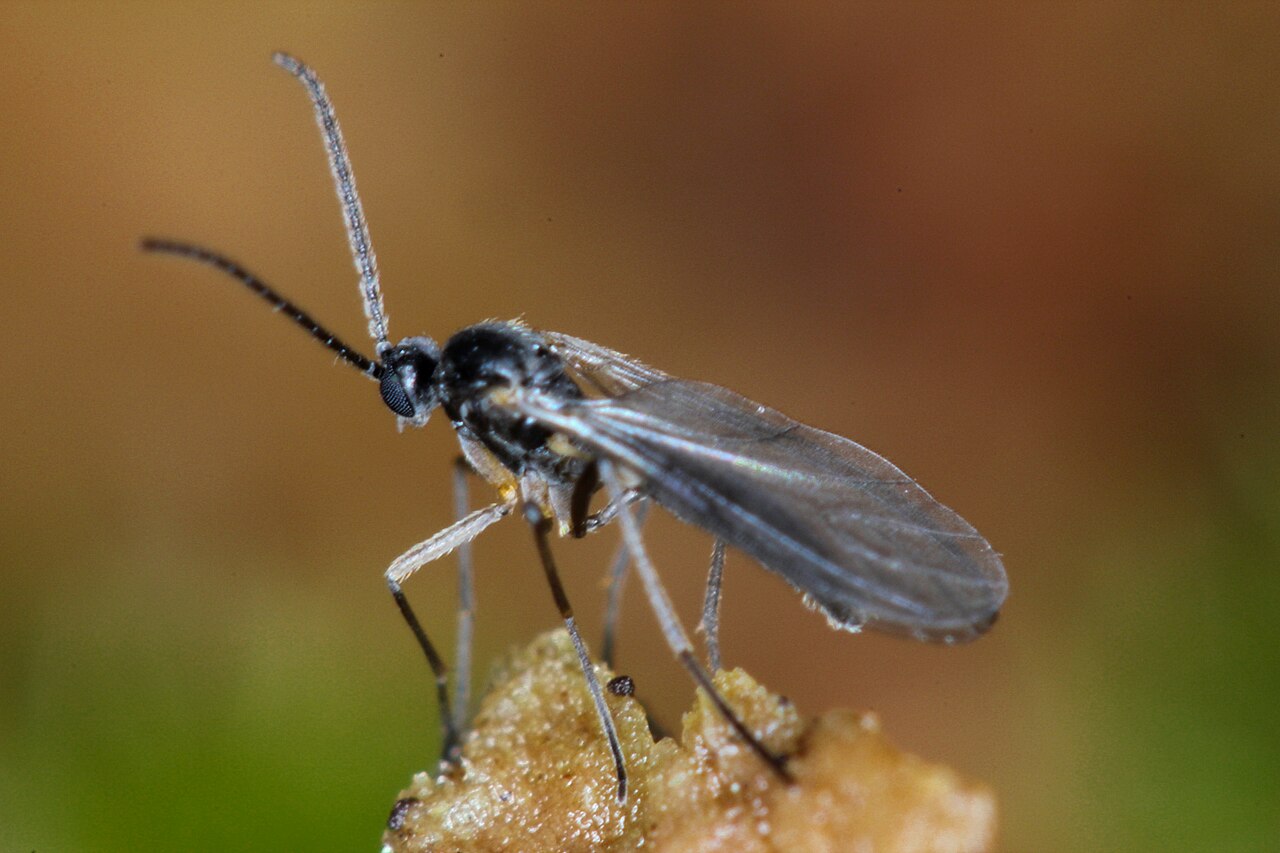
Adults gnats are often found around the garden where they seek out moist, watered soils.
Fungus Gnats never settle in dry soils of the garden or out in the wilderness as they are dependent on moisture to lay eggs in the ground.
Plant damage caused by fungus gnats
Adult Fungus Gnats don’t cause any type of damage to plants as they don’t eat plants. It’s their emerging larvae that cause the most damage.
Fungus Gnats larvae feed on the plants as they grow. Since they grow in the ground, they can only feed on plant roots, often slowly killing a plant when infestations re-occur.
These types of gnats don’t kill large plants as the younger plants tend to be the most impacted when their roots are eaten by the larvae.
2. Melon Aphid
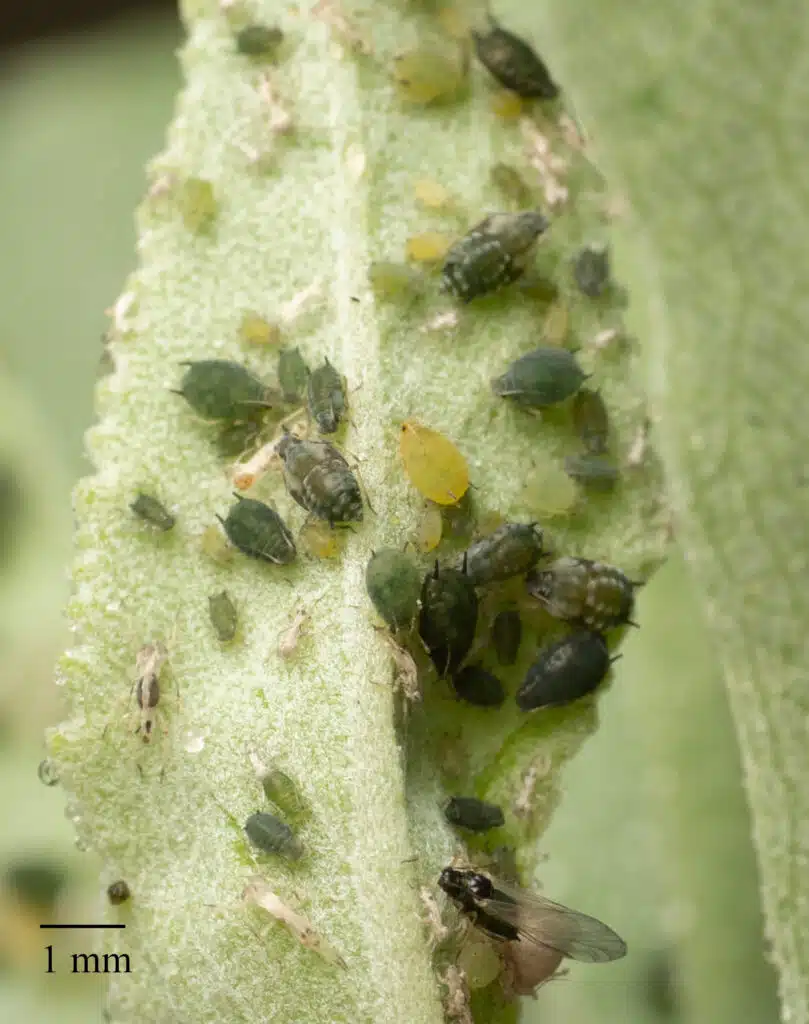
Some of the most impacted fruits of vegetables suffer from Melon Aphid invasions (Aphis gossypii).
These small black bugs are seen on different types of melons, cantaloupes, and pumpkins.
Nobody knows where these bugs came from in North America.
Some of the highest numbers of Melon Aphids are specific to tropical climates of the world. They have since spread to almost any type of climate in North America where melons grow.
Plant damages caused by Melon Aphids
Both the nymph and the adult Melon Aphid cause direct damage to their host.
They feed on the leaves of their hosts. They might be difficult to spot initially as they only feed on the underside of the leaves.
As they grow, they skeletonize leaves, hindering further melon growth.
These types of aphids also cover their hosts in thick sticky honeydew which is further known to attract flies and ants.
Apart from melons, citruses, and cotton fields may also suffer in the case of large-scale Melon Aphid invasions.
3. Cowpea Aphid

Winged Cowpea Aphids (Aphis craccivora) are some of the typical types of black bugs you can find in the garden or on crops.
Females of the species have a small body of up to 2.2mm with a shiny black uniform color. Their wings help quickly move around from one plant to another for food.
Limited damages are specific to the Cowpea Aphid. This is a species that has many types of wildflower and legume hosts, but it generally doesn’t kill all of these types of hosts.
Plant damages caused by the Cowpea Aphid
One of the major impacts of the species is made on plants in the pea family or on plants in the cabbage family.
These types of aphids further feed on pumpkins, cowpeas, and chickpeas.
Initial damages are small and plants may only be impacted to the limit of stunted growth. However, large invasions may end up covering these legumes in honeydew and stopping proper photosynthesis.
A considerable impact on plants is rare unless they spread out some type of plant disease.
Cowpea Aphids can spread viruses such as the peanut stunt virus which causes plant dwarfing.
4. Black Bean Aphid

Black Bean Aphids (Aphis fabae) show an aggressive feeding partner and the capacity to overwinter as adults.
These are small black bugs with yellow legs which often invade plants in their hundreds.
All Black Bean Aphids are female which means these are the types of bugs that can multiply by cloning themselves quickly.
The summertime marks the period when their move from their overwintering spots close to The European Spindle to various crops.
Plant damages caused by the Black Bean Aphid
Both adult and nymph Black Bean Aphids are major pests of numerous crops. Sugar beet and beans are among the most impacted plants.
These bugs feed by sucking the sap directly out of these plants, mainly in their hundreds as they colonize each host plant.
Dwarfism is common when it comes to the impact these aphids have on plants.
Young leaves and stems of the plants attract these aphids which can move to younger plants from their aging host plant.
5. Smoky Poplar Aphid
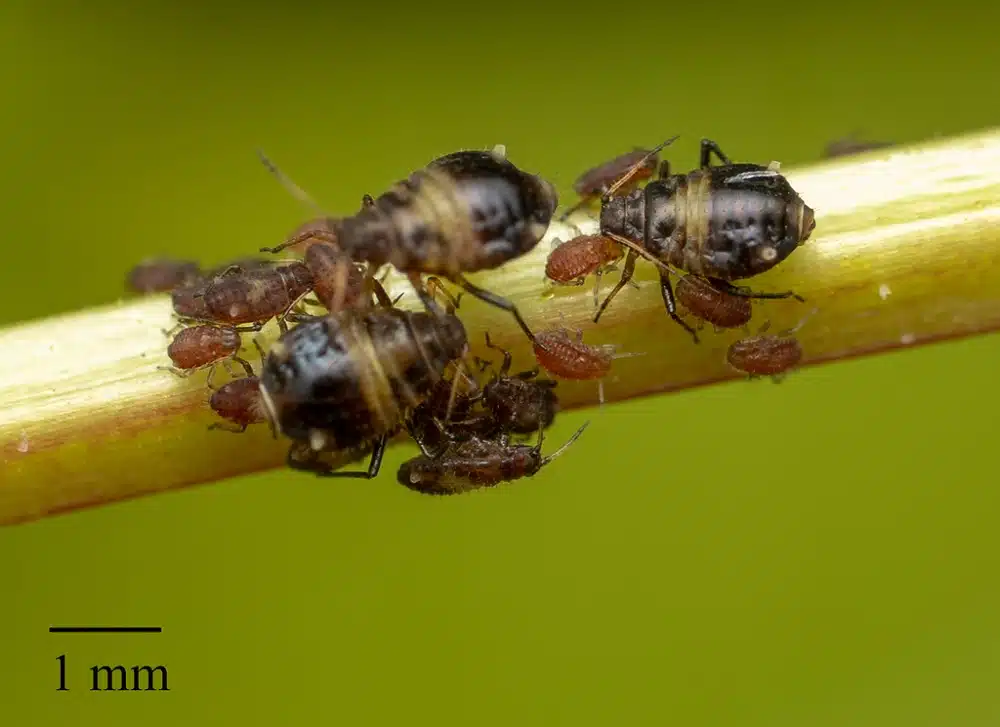
A North American native, the Smoky Poplar Aphid (Chaitophorus populicola) gets its name from its smoky brown or black coloring.
These shiny aphids can be winged or wingless and they are spotted along some of the most common native trees in North America, such as poplar.
Aphids of this genus are further known to have orange nymphs, which live together with adults.
Plant damages caused by The Smoky Poplar Aphid
Poplar and aspen are the main host trees of these aphids. Their leaves, particularly the young ones, are of the greatest interest to these specialized aphids.
They feed on tree leaves from a young age and they eventually end up eating entire tree leaves.
Complete defoliation might be a rare sight as these aphids are generally eaten by some of their predators such as wasps and small birds.
Some types of ants are also attracted to these trees as these aphids excrete the excess sugar in the aspen and poplar leaves.
Spotting these aphids is generally predicated on spotting different types of aphids that eat their residue honeydew as well.
6. Flea Beetles

Some of the most common black bugs in gardens are Flea Beetles (Alticini). Various sub-species of these beetles all have black coloring, or black with yellow and red coloring.
A small bug, these beetles are a considerable pest that requires proper management techniques.
However, not all Flea Beetles are pests. Some of them only eat invasive plants which makes them a welcomed sight in gardens.
Plant damages caused by Flea Beetles
Thyme, mint, and even flowers such as gardenia are generally impacted by flea beetles.
Feeding on plants, cause stunt growth or even plant death when left unmanaged.
Most Flea beetles have a detrimental role in the health of various plants while others have a positive role by eating common weeds.
Aphthona is a genus of Flea Beetles that are known to eat some of the typical invasive plants in the Western parts of North America.
7. Twice-stabbed Lady Beetle

A shiny black color with 2 large red spots on the elytra is specific to The Twice-stabbed Lady Beetle (Chilocorus stigma).
The juxtaposed red spots of the species inspire its name as the species looks stabbed.
Much of its North American range is well documented in Southern US states. It has a coast-to-coast presence from Florida to California.
Plant damages caused by The Twice-stabbed Lady Beetle
Twice-stabbed Lady Beetles don’t have a negative effect on plants, as predator bugs.
A positive role in the ecosystem is attributed to the species. They eat various types of aphids that damage plants and may sometimes be perceived as detrimental black bugs on plants.
Aphids are the main prey of these black bugs. They eat all types of aphids in gardens or in woodlands, limiting their impact on the host tree, plant, or wildflower.
Twice-stabbed Lady Beetles are an important species when it comes to the control of invasive species as well.
While not as successful against invasive bugs as against aphids, these black bugs can help reduce invasive populations that eat trees such as hemlock, as in the case of the elongated hemlock scale.
8. Black Caterpillar Hunter Beetle

A small to medium-sized bug on plants, The Black Caterpillar Hunter Beetle (Calosoma sayi) measures up to 28mm.
A black grooved elytron is specific to this species.
It lives in various habitats such as across grasslands and woodlands at low and high altitudes.
Plant damages caused by The Black Caterpillar Hunter Beetle
This black bug doesn’t eat plants or damage any plants as a predatory species.
It eats various insects and it feeds on a wide variety of caterpillars.
A positive role is attributed to the species as it feeds on caterpillars that eat and skeletonize leaves.
Its grubs hide from cold weather in the soil and emerge as adults in the spring, together with many species of pest caterpillars.
The beneficial role of the species is even more important as this bug lives long. It can survive up to 3 years.
9. White-margined Burrower Bug

The White-margined Burrower Bug (Sehirus cinctus) is a typical bug on lawns.
Its coloring varies from all-black to partial black and red.
Nettle and mint are among the most common plants the species is seen on. Cultivated mint represents less of an interest to the species as opposed to mint species in the wilderness.
Plant damages caused by the White-margined Burrower bug
Both a detrimental and a positive role has been attributed to the White-margined Burrower Bug.
This is a species that can be seen eating some of the most invasive weeds on lawns. Henbit is one of the weeds the White-margined Burrower Bug helps control on lawns.
From here, the bug can migrate into gardens on peppermint, but it prefers to live on lawns as long as there are weeds and or herbaceous plants around.
10. Black Stink Bug

Florida and other Southern states such as Texas are the North American home of the Black Sting Bug (Proxys punctulatus).
This is a specific species of tropical and subtropical climates that has made its way into North America.
Almost all-black, this shield-shaped species also shows tiny yellow dots and yellow spots across its legs and antennae.
Plant damages caused by the Black Sting Bug
A major pest in Southern Florida and Southern US, these types of bugs suck plant sap, essentially killing a host in case of an invasion.
Some of the crops this type of stink bug is a pest of include cotton and soybean.
All types of citruses can be impacted by the Black Stink Bug in Florida as well as in Mexico or Guatemala.
Trap crops are used against this species in organic farming.
11. Garden Fleahopper

A shiny black color with tiny yellow spots is characteristic of The Garden Leafhopper (Microtechnites bractatus).
This is a typical species that is one of the most important pests on a wide range of crops.
Unlike aphids that may be specialized in a certain legume or category of legumes, Garden Leahoppers are interested in multiple types of legumes.
Some of the management techniques of the species include preventive action as well as insecticide use.
Plant damage caused by Garden Leafhoppers
These types of bugs eat a broad range of legumes and their leaves. Eggplant, potatoes and sweet potatoes, lettuce, kale, and alfalfa cover crops are all impacted by the species.
Lettuce and other legumes suffer visible damage and holes in leaves which make them inappropriate to sell in stores.
As a result, these are the types of bugs farmers are mostly afraid of. The insecticide is used against Garden Leafhoppers outside organic farming.
12. Toyon Gall Thrips
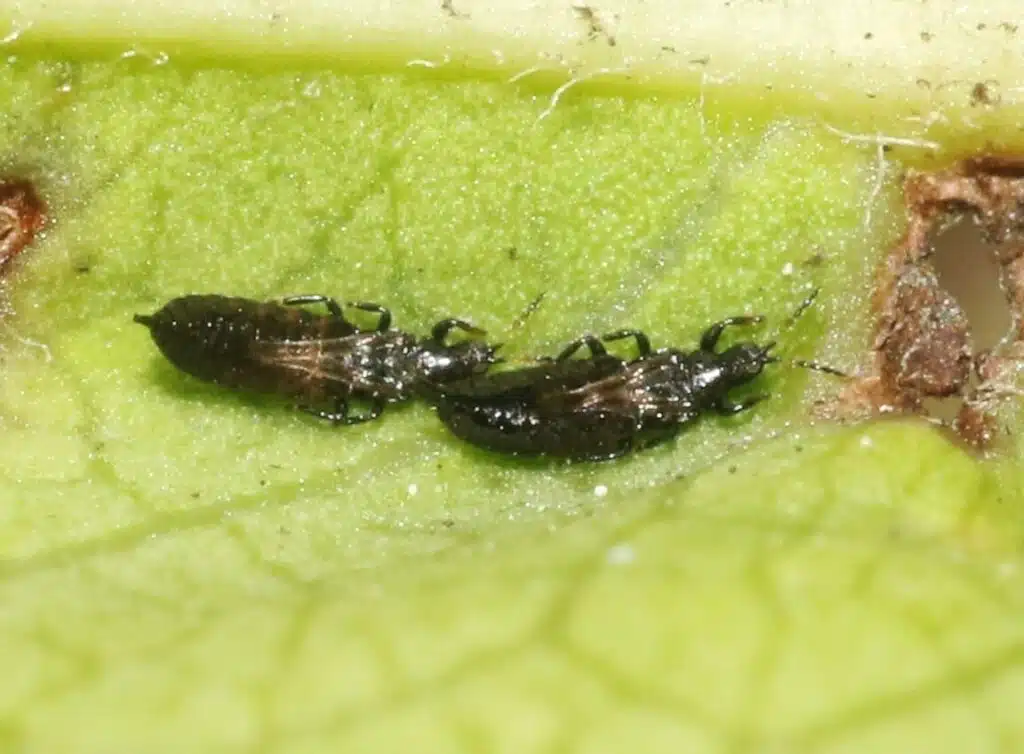
Mostly black color is specific to the Toyon Gall Thrips (Liothrips ilex).
These are black elongated bugs with a few yellow segments along their body.
Almost all Toyon Gall Thrips of the US are found on The West Coast, particularly in California as this is where their host plants are abundant.
Plant damages caused by Toyon Gall Thrips
Toyon Gall Thrips are a pest of Californian Toyon. They also feed on similar other wildflowers such as Christmasberry shrubs.
Eating these plants excessively means there’s less available food for species such as butterflies and caterpillars of California that also eat toyon.
13. Naio Thrips
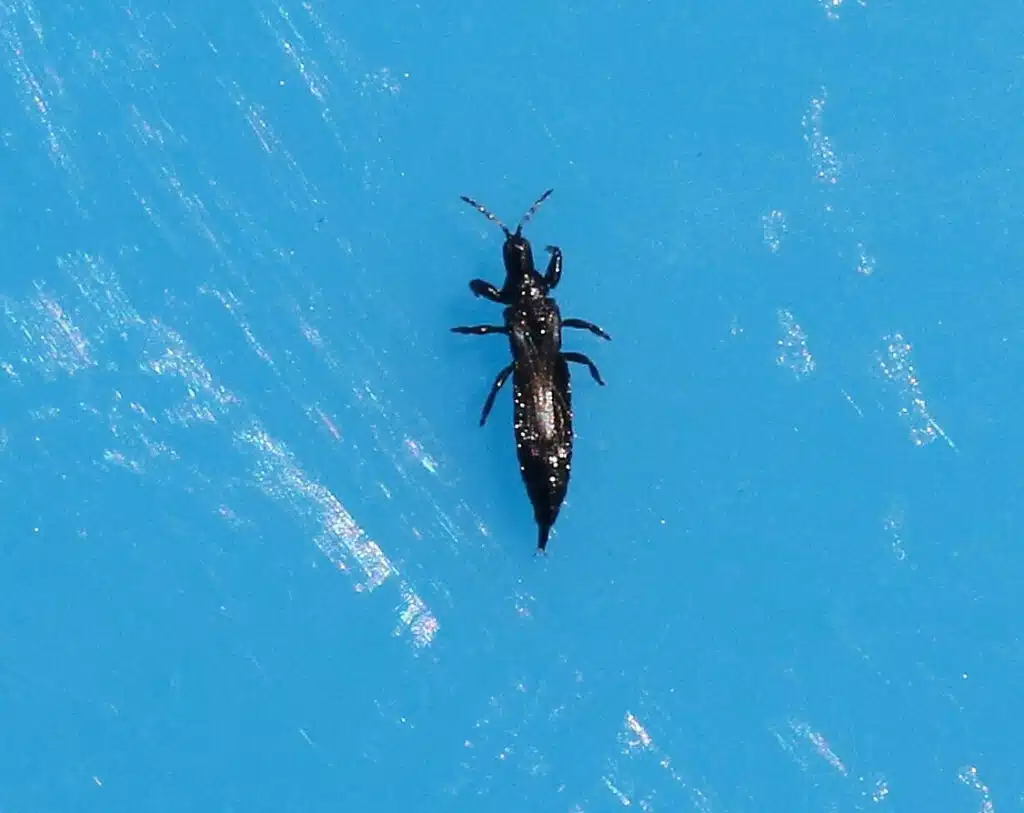
Native to Southern California, Naio Thrips (Klambothrips myopori) have an elongated tapering black body.
The species is one of the invasive pests of Myoporum plants. It feeds on the small fruits and on the leaves of the species.
These types of thrips can also spread out their damage to gardens where the Myoporum plants are grown.
Plant damages caused by Naio Thrips.
Naio is the native California and Hawaii species that are most affected by Naio Thrips.
This species may be known as False Sandalwood based on its resemblance to actual sandalwood.
Pruning Naio which may be used for hedging is one of the recommended prevention techniques. Naio becomes invasive outside of its native range and it’s best to avoid it in the first place.
14. Black Spider Mites

Black and yellow coloring are specific to the tiny Black Spider Mite. This is a species that is even barely visible to the naked eye.
Most black and round, Black Spider Mites feed on the underside of various plant leaves.
Specific action needs to be taken to prevent these types of mites as they can invade crops and gardens.
Plant damages caused by Black Spider Mites
Small yellow spots are seen in the place where the small mouthparts of Black Spiders Mites have sucked plant sap.
Invasions are problematic for species such as cucumbers, strawberries, and tomatoes.
Damages to plants and legumes may continue with damages to trees and flowers such as roses.
15. Earwigs

Dark brown to black coloring is specific to some types of earwigs. These are a type of elongated bug with long pincers and fast movements that has a very varied diet.
Earwigs can eat all types of plants, including decaying plants.
Vegetables and flowers are all part of its diet. The species is also an insectivore, eating all types of smaller insects it can overpower.
Plant damages caused by earwigs
Earwigs have a split role that’s both beneficial and detrimental to plants and the ecosystem.
They can eat some of the typical invasive bugs on plants, such as aphids and mites.
Earwigs are also detrimental to plants and fruits as they eat their fruits, leaves, and stems, stunting their growth or impacting their spreading capacity.
16. Black Olive Scale

Florida and California are states where the Black Olive Scale (Saissetia oleae) is highly present.
This is a small species with an important economic impact as a considerable pest of olives and citruses.
The species may also feed on apricots, especially in irrigated areas.
Plant damages caused by Black Olive Scales
This species feeds by sucking sap from plant tissue. The scale insects feed on the stems of their host.
Residual honeydew also impacts its plants by attracting ants. This type of sticky residue also favors sooty mold formation on its host plants.
17. Black Scale

Black Scales (Parasaissetia nigra) are tiny round insects that feed on plant sap. Similar to black lady beetles, these bugs can feed on almost any type of plant.
Plant damages caused by Black Scales
Honeydew secretions of these bugs attract all types of insects to host plants.
Apart from attracting ants, these types of bugs can feed on plant sap until the host plant dies.
Multiple small Black Scales can fee don a single leaf or a single stem, before moving to an unaffected area of the plant.
Some of the typical small-scale management techniques of the species include washing down the plants with a gardening hose.
How to Get Rid of Black Bugs on Plants
Some of the most common ways of getting rid of black bugs on plants include preventive measures as well as quick action measures depending on each species.
Use trap crops
Admiral pea, millet, or okra trap crops are often used against black bugs on some of your preferred plants, legumes, or greens.
You plant trap crops in between your actual crops as a means to deter these bugs away. They are attracted to the trap crops, reducing or even eliminating the chances of them feeding on your legumes or plants.
You can use trap crops along with legumes and fruits. They can be highly efficient against black aphids.
Remove weeds and invasive plants henbit
Weeds tend to attract different types of bugs as opposed to regular plants, especially in the case of invasive species.
Some local species might also feed on invasive plants, but many invasive species spread out quicker than local plants.
This means invasive plants may attract a higher number of bugs through their higher numbers along.
Make sure to remove all weeds around crops and gardens to keep all types of black bugs away efficiently.
Introduce predatory species
Parasitic wasps such as Metaphycus helvolus are among the multiple species which can control different types of invasive bugs.
Lady beetles are among the beneficial black bugs that need to be left alone in the garden as they help reduce pest bug populations.
Predatory species can be introduced when purchased in bulk. They can also be encouraged by not using insecticide or pesticide which isn’t always successful against all types of black pest bugs.
Predatory species are often responsible for ending an invasion in the garden, on crops, or around woodlands where they naturally control outbreaks.
Use insecticide or horticultural oils
Insecticide might be required on crops against certain types of black bugs. Similarly, horticultural oils can be applied once or multiple times per year to keep all types of black bugs away.
These types of chemicals may only be applied by professionals. They aren’t considered in organic farming in gardens where you only rely on naturally-sourced produce and ingredients.
Insecticide resistance is species-resistant so each type of bug needs to be correctly identified to check its reactions to chemical management techniques.
Reduce plant watering frequency
Damp soil is one of the ideal places for black bugs to hide in. Many species may hide in this type of soil during the day, as nocturnal creatures.
Other species such as certain flies may only lay eggs in humid soil. Furthermore, bugs may also be attracted to damp soil when seeking overwintering locations.
Black bugs on plants may seek out damp soils to overwinter as adults. Most species, on the other hand, overwinter in damp soil in an egg stage.
Use essential oils
Essential oils are a natural prevention method used instead of insecticides. Most types of essential oils might only be used on a small scale, such as in gardens or on plants around the house.
Lavender essential oil drops and water may be mixed and sprayed on some of the most important flowers, legumes, and fruits in the garden as preventive measures against multiple bugs, including black bugs.
Tea tree essential oil is often sprayed on various flowers as a preventive method against all types of bugs as well.
Eucalyptus essential oil has a very aromatic fragrance which bugs hate. You may mix it with lukewarm water before spraying it on plants which then coats them with a repelling invisible layer.
The sweet orange essential oil may also be used against many types of black beetles.
Consider washing the plants with a gardening hose
Aphids and their nymphs are among the common bug species that can be washed away with water. A low-pressure gardening hose might be used against them.
This solution can be efficient against a large number of aphids on plants which would take too long to pick by hand.
Make sure to limit the maximum water pressure to avoid damaging the leaves, stems, or flowers of your growing plants.
Manually remove bugs from plants
Most types of black bugs on plants listed above don’t bite. They can be removed by hand as soon as spotted.
You may easily remove larger bugs that are easier to handle but you may have a more difficult time removing barely-visible mites.
Aphids are among the typical types of bugs people remove by hand. This solution can be a quick method to eliminate invaders.
Make sure there are no eggs laid around the plant once the bug is removed. While often too small to be spotted individually, bug eggs may be laid in clumps and are easier to spot.
Refrain from planting invasive species
Some bugs such as Flea Beetles are specifically known to be attracted by invasive weeds.
Apart from reducing the available nutrients for your plants, invasive weeds often attract new bug species to your garden.
One of the ways of keeping these bugs out is to remove all invasive species completely. Even a single plant may eventually spread and attract these bugs to your garden.
Frequently mowing the lawn and removing all types of weeds both on it and around the lawn is the first step to keeping these types of black beetles away.
Weeds in the garden might also attract different types of bugs. Make sure you act soon before they spread and attract invasive pest black bugs which also eat your plants.